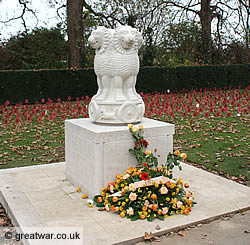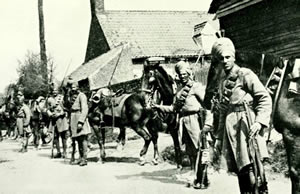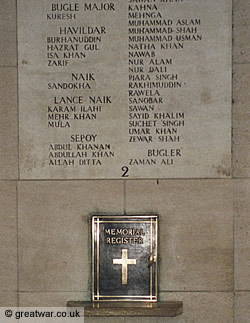Indian Forces Memorial, Ypres
This memorial was unveiled in a ceremony in March 2011. It is dedicated to the 130,000 troops of the Indian Forces who served in Flanders during the Great War of 1914-1918. 9,000 members of the Indian Expeditionary Force died as casualties in France and Flanders, not only due to the nature of their injuries in battle but also due to the severe winter weather conditions they were exposed to.
Indian Expeditionary Force

|
In the First World War the British Indian Army in the British Raj sent 7 Indian Expeditionary Forces with over a million troops to serve with the British Army and her Allies in various theatres of war. Of the 7 Indian Expeditionary Forces, named A to G, the Indian Expeditionary Force A served on the Western Front attached to the British Army in battle against the Imperial German Army.
Indian Army on the Western Front
Two Army Corps made up of four divisions were sent from India:
- one infantry corps, the 1st Indian Corps comprising two divisions: 7th (Meerut) Division and 3rd (Lahore) Division
- one cavalry corps, formed on arrival in France as the Indian Cavalry Corps: 1st Indian Cavalry Division and 2nd Indian Cavalry Division
The Indian Expeditionary Force A arrived in the Mediterranean French port of Marseilles between the end of September and mid October 1914. They were deployed to the battle sector of what was to become the Ypres Salient. In those early weeks of the war the Indian Force took part in the First Battle of Ypres from October to November 1914. In the early spring of 1915 the Indian Force provided the lead division in the Allied offensive in French Flanders against the German Army at the Battle of Neuve Chapelle (10 - 13 March 1915). They continued to fight in French Flanders in 1915 in the Battle of Aubers Ridge (9 May), the Battle of Festubert (15 - 27 May) and the Battle of Loos (25 September - 8 October 1915).

|
During the winter months of November and December 1915 arrangements were made to remove the two Indian infantry divisions of 1st Indian Corps from the Western Front. The two divisions of 1st Indian Corps were sent to the Mesopotamian theatre of war.
The two Indian cavalry divisons remaining in France were renamed from March 1916 as the 4th and 5th Cavalry Divisions. They were in the order of battle for the British offensive on the Somme battlefield from 1 July 1916. Indian cavalry units were involved as mounted troops and dismounted infantry troops in battles on the Western Front from that time until their removal to Egypt in March 1918. Battle actions in France included the Battle of Bazentin (14th-17th July 1916, the Battle of Flers-Courcelette (15 - 22 September 1916), the advance to the Hindenburg Line in the spring of 1917 and the 1917 Battle of Cambrai (20 November - 8 December 1917).
Location of the Indian Forces Memorial, Ypres
The Indian Forces Memorial is located on the Ramparts on the south side of the Menin Gate Memorial to the Missing.
Visitors can get to the Ramparts and the Indian Forces Memorial via the steps in the southern stairway of the Menin Gate. Or, for visitors who wish to avoid steps, access up to the Ramparts can be made by using the sloped path from the western end of the Menin Gate Memorial where the path starts at the junction of Meensestraat and Bollingstraat.
Related Topics
Menin Gate Memorial Indian Commemoration
The names of Indian Army casualties who died on the Ypres Salient battlefields are commemorated on the panels at the western end of the Menin Gate Memorial to the Missing.
Menin Gate Memorial to the Missing
Western Front Battles
An overview of battles on the Western Front in which the Indian Army took part can be found on our pages at:
Battles of French Flanders & Artois
Acknowledgements
(GWPDA) Photograph with grateful thanks to the Great War Primary Document Archive (GWPDA): Photos of the Great War. Photograph source: With Our Army in Flanders; Edward Arnold, London, 1915.
Website: www.gwpda.org

